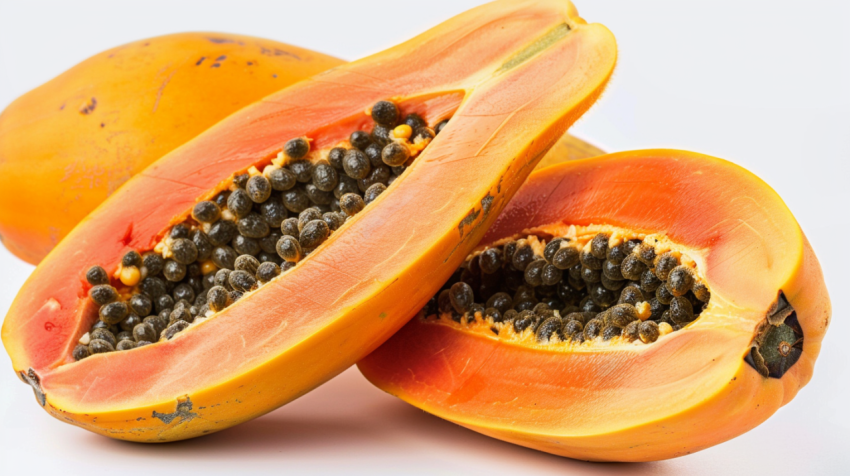









Papaya: The Tropical Fruit with Digestive Benefits and Sweet Flavor
The papaya, a tropical fruit known for its vibrant orange flesh, sweet flavor, and digestive benefits, is a nutritional powerhouse and a culinary delight. Native to Central America, papayas are now cultivated in many tropical and subtropical regions around the world. They are enjoyed fresh, used in smoothies, salads, and desserts, and even incorporated into savory dishes. Beyond their delicious taste, papayas offer a range of health benefits, particularly due to their unique enzymes.
1. The Origins of Papaya: A Tropical American Native
The papaya's origins can be traced back to Southern Mexico and Central America:
- It was cultivated by indigenous peoples of Mesoamerica for centuries before the arrival of Europeans.
- The papaya was introduced to the Caribbean and other tropical regions by Spanish and Portuguese explorers in the 16th century.
- It quickly spread to other parts of the world with suitable climates, including Asia, Africa, and the Pacific Islands.
2. Papaya Varieties: A Range of Shapes and Sizes
There are two main types of papayas:
- Mexican Papayas: These are larger, sometimes weighing up to 10 pounds, with flesh that can range from yellow to orange to red. Their flavor can be less intense than Hawaiian papayas.
- Hawaiian Papayas (or Solo Papayas): These are smaller, pear-shaped papayas, typically weighing around 1 pound. They are known for their vibrant orange-red flesh and sweet, musky flavor. These are the most commonly found in US grocery stores.
- There are many different cultivars within each of these categories.
3. Nutritional Powerhouse: The Health Benefits of Papaya
Papayas are a nutrient-rich fruit, offering a variety of health benefits:
- Digestive Enzymes: Papayas are renowned for their high content of papain, a proteolytic enzyme that aids in the digestion of proteins. They also contain chymopapain which also helps with digestion.
- Vitamin C: An excellent source of vitamin C, an antioxidant that supports immune function and collagen production.
- Vitamin A: Papayas contain carotenoids, including beta-carotene, which the body converts into vitamin A, essential for vision and immune health.
- Fiber: Papayas provide dietary fiber, which aids digestion, promotes satiety, and helps regulate blood sugar levels.
- Folate: A B vitamin that is important for cell growth and development, particularly during pregnancy.
- Potassium: An electrolyte that helps regulate blood pressure and muscle function.
- Antioxidants: Papayas contain various antioxidants, which may help protect against chronic diseases.
4. Culinary Uses: From Sweet to Savory
Papayas are incredibly versatile in the kitchen:
- Fresh Eating: Ripe papayas are delicious eaten fresh, often with a squeeze of lime juice.
- Smoothies: Papayas add a tropical flavor and creamy texture to smoothies.
- Salads: They can be added to fruit salads or savory salads for a touch of sweetness and color.
- Desserts: Papayas can be used in desserts like papaya sorbet, papaya ice cream, and papaya tarts.
- Juice: Papaya juice is a refreshing and nutritious beverage.
- Sauces and Marinades: Green (unripe) papaya can be used in savory dishes and to tenderize meat due to the papain enzyme.
- Chutneys and Salsas: Adds sweetness and a tropical element.
5. Papaya and Digestion: The Power of Papain
- Papain, the enzyme found in papayas, is often used as a meat tenderizer and as a digestive aid.
- It helps break down proteins, making them easier to digest.
- Papain supplements are available for those seeking digestive support.
6. Growing Papayas: A Tropical Crop
Papaya trees thrive in tropical and subtropical climates:
- They require warm temperatures, plenty of sunlight, and well-drained soil.
- Major papaya-producing countries include India, Brazil, Mexico, Indonesia, and Nigeria.
- Papaya trees are fast-growing and can produce fruit within a year of planting.
- They are typically propagated from seeds.
7. Papaya in Traditional Medicine
- Papaya has been used in traditional medicine in various cultures to treat a range of ailments, including digestive problems, inflammation, and skin conditions.
- More research is needed to determine effectiveness for many of these uses.
8. The Future of Papaya
- The demand for papayas continues to grow as consumers seek out healthy and exotic fruits.
- Researchers are working to develop papaya varieties that are more resistant to diseases and have improved shelf life.
- The papaya industry is exploring more sustainable growing practices.
Conclusion:
The papaya, with its vibrant color, sweet flavor, and impressive nutritional profile, is a true tropical treasure. From its origins in Mesoamerica to its global cultivation, the papaya has a rich history and continues to be enjoyed for its culinary versatility and health benefits. Whether eaten fresh, blended into a smoothie, or used in a savory dish, the papaya offers a delicious and nutritious way to add a taste of the tropics to our diets. As research continues to uncover the full extent of its health-promoting properties, the papaya's popularity is sure to continue to grow.
Papaya, papaya fruit, papaya benefits, papaya nutrition, papaya recipes, papaya enzymes, papain, types of papayas, Mexican papaya, Hawaiian papaya, Solo papaya, papaya history, where do papayas grow, how to eat papaya, papaya smoothie, papaya salad, papaya dessert, papaya juice, green papaya, unripe papaya, papaya seeds, papaya leaves, papaya for digestion, papaya for skin, growing papayas, papaya tree, papaya plant, health benefits of papaya, papaya calories, papaya and weight loss, buy papayas online, papaya price, organic papayas.

